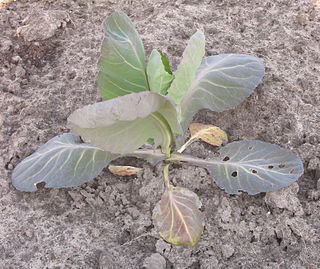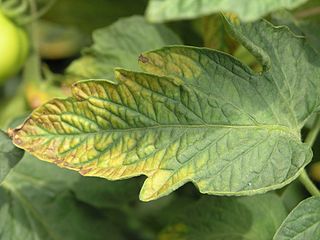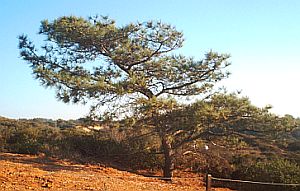 W
WPhysiological plant disorders are caused by non-pathological conditions such as poor light, adverse weather, water-logging, phytotoxic compounds or a lack of nutrients, and affect the functioning of the plant system. Physiological disorders are distinguished from plant diseases caused by pathogens, such as a virus or fungus. While the symptoms of physiological disorders may appear disease-like, they can usually be prevented by altering environmental conditions. However, once a plant shows symptoms of a physiological disorder it is likely that, that season’s growth or yield will be reduced.
 W
WBitter pit is a disorder in apple fruits, now believed to be induced by calcium deficiency. It occurs less commonly in pears.
 W
WCalcium (Ca) deficiency is a plant disorder that can be caused by insufficient level of biologically available calcium in the growing medium, but is more frequently a product of low transpiration of the whole plant or more commonly the affected tissue. Plants are susceptible to such localized calcium deficiencies in low or non-transpiring tissues because calcium is not transported in the phloem. This may be due to water shortages, which slow the transportation of calcium to the plant, poor uptake of calcium through the stem, or too much nitrogen in the soil.
 W
WIn botany, chlorosis is a condition in which leaves produce insufficient chlorophyll. As chlorophyll is responsible for the green color of leaves, chlorotic leaves are pale, yellow, or yellow-white. The affected plant has little or no ability to manufacture carbohydrates through photosynthesis and may die unless the cause of its chlorophyll insufficiency is treated and this may lead to a plant diseases called rusts, although some chlorotic plants, such as the albino Arabidopsis thaliana mutant ppi2, are viable if supplied with exogenous sucrose.
 W
WFertilizer burn is leaf scorch resulting from over-fertilization, usually referring to excess nitrogen salts.
 W
WGummosis is the formation of patches of a gummy substance on the surface of certain plants, particularly fruit trees. This occurs when sap oozes from wounds or cankers as a reaction to outside stimuli such as adverse weather conditions, infections, insect problems, or mechanical damage. It is understood as a plant physiological disease.
 W
WIron (Fe) deficiency is a plant disorder also known as "lime-induced chlorosis". It can be confused with manganese deficiency. Soil iron concentration is high, but can become unavailable for absorption if soil pH is higher than 6.5. Also, iron deficiency can develop if the soil is too waterlogged or has been overfertilised. Excess of elements such as manganese in the soil can interfere with plant iron uptake triggering iron deficiency.
 W
WManganese (Mn) deficiency is a plant disorder that is often confused with, and occurs with, iron deficiency. Most common in poorly drained soils, also where organic matter levels are high. Manganese may be unavailable to plants where pH is high.
 W
WMicronutrient deficiency or dietary deficiency is not enough of one or more of the micronutrients required for optimal plant or animal health. In humans and other animals they include both vitamin deficiencies and mineral deficiencies, whereas in plants the term refers to deficiencies of essential trace minerals.
 W
WMolybdenum (Mo) deficiency occurs when plant growth is limited because the plant cannot take up sufficient quantities of this essential micronutrient from its growing medium. For crops growing in soil, this may be a result of low concentrations of Mo in the soil as a whole, or because the soil Mo is held in forms that are not available to plants – sorption of Mo is strongest in acid soils.
 W
WAll plants require sufficient supplies of macronutrients for healthy growth, and nitrogen (N) is a nutrient that is commonly in limited supply. Nitrogen deficiency in plants can occur when organic matter with high carbon content, such as sawdust, is added to soil. Soil organisms use any nitrogen to break down carbon sources, making N unavailable to plants. This is known as "robbing" the soil of nitrogen. All vegetables apart from nitrogen fixing legumes are prone to this disorder.
 W
WThe following outline is provided as an overview of and topical guide to organic gardening and farming:
 W
WPhosphorus deficiency is a plant disorder associated with insufficient supply of phosphorus. Phosphorus refers here to salts of phosphates (PO43−), monohydrogen phosphate (HPO42−), and dihydrogen phosphate (H2PO4−). These anions readily interconvert, and the predominant species is determined by the pH of the solution or soil. Phosphates are required for the biosynthesis of genetic material as well as ATP, essential for life. Phosphorus deficiency can be controlled by applying sources of phosphorus such as bone meal, rock phosphate, manure, and phosphate-fertilizers.
 W
WPotassium deficiency, also known as potash deficiency, is a plant disorder that is most common on light, sandy soils, because potassium ions (K+) are highly soluble and will easily leach from soils without colloids. Potassium deficiency is also common in chalky or peaty soils with a low clay content. It is also found on heavy clays with a poor structure.
 W
WSalt pruning is the process by which saline mists generated by seawater are driven ashore by winds and thus over time alter the shape of trees or shrubs. The process degrades foliage and branches on the windward side of the plant that faces the body of saline water, more than it does the foliage on the landward side. The resultant growth form is asymmetrical, appearing "swept back" away from the ocean.
 W
WZinc deficiency occurs when plant growth is limited because the plant cannot take up sufficient quantities of this essential micronutrient from its growing medium. It is one of the most widespread micronutrient deficiencies in crops and pastures worldwide and causes large losses in crop production and crop quality.